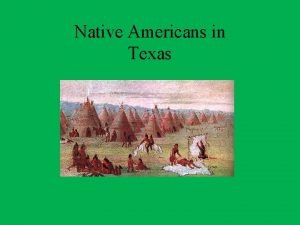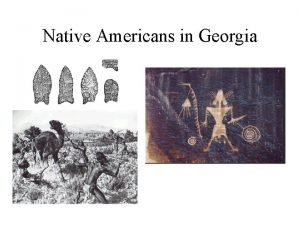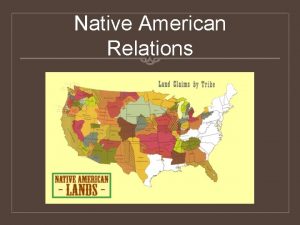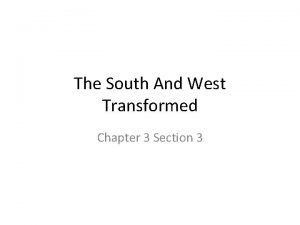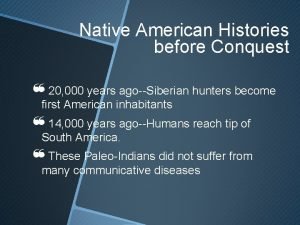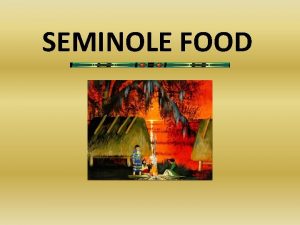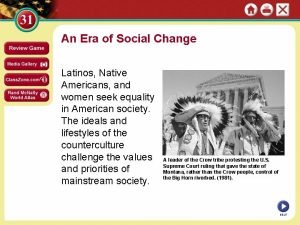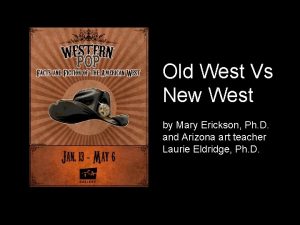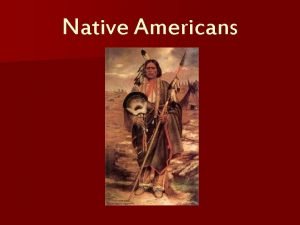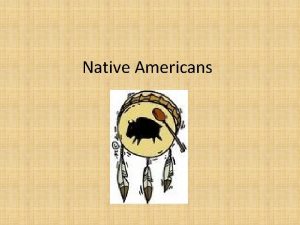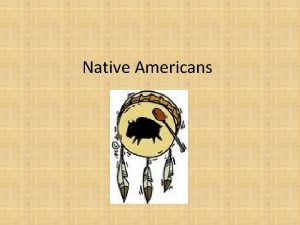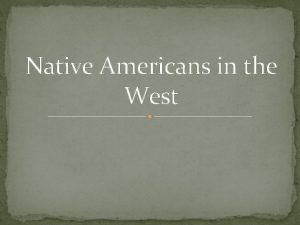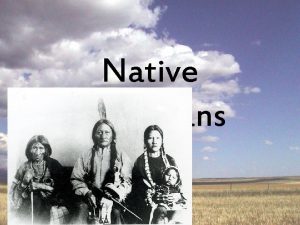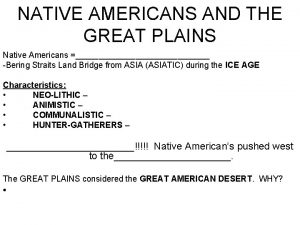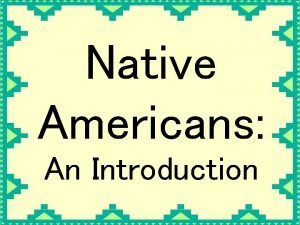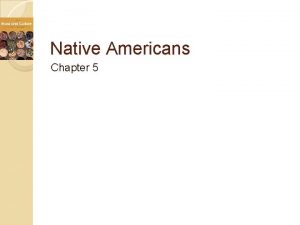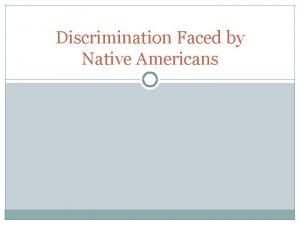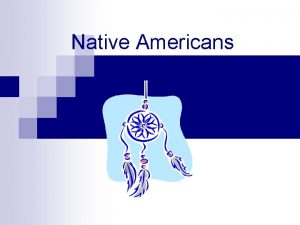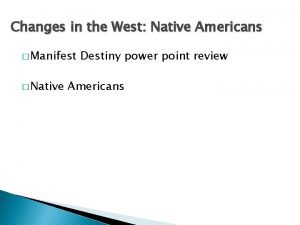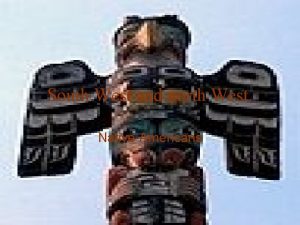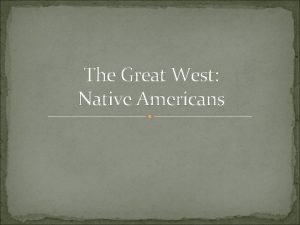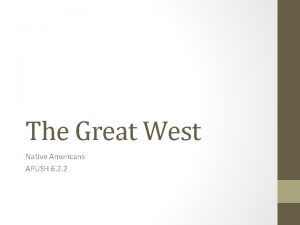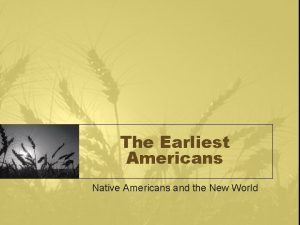The Great West Native Americans The Culture of






















- Slides: 22

The Great West Native Americans

The Culture of the Great Plains Indians • Distinctive and highly developed Native American ways of life existed on the Great Plains • To the east, near the lower Missouri River, tribes such as the Osage and Iowa had hunted and planted crops, settled in small villages for over a century. • Farther west, nomadic tribes such as the Sioux and Cheyenne gathered wild foods and hunted buffalo. • People of the Plains abided by tribal law, traded and produced beautifully crafted tools and clothing

The Horse and the Buffalo • After the Spanish brought horses to New Mexico in 1598, Native American way of life began to change • As natives acquired horses and then guns, they began to travel more efficiently • By the mid 1700 s almost all of the tribes roamed the plains to hunt buffalo • This increased mobility caused tribal infighting and war. Taking part in war parties and raids earned prestige. A Plains warrior gained honor by killing his enemies as well as by “counting coup”. • Truces called between warring tribes allowed tribes to trade goods, share news and attend harvest festivals


Family Life • Native Americans usually lived in small extended families with ties to other bands that spoke the same language. • Young men became hunters and warriors • Women helped butcher the game • Believed powerful spirits controlled events in the natural world • Children learned proper behavior and culture through stories and myths • No individual was allowed to dominate the group; leaders of a tribe ruled by counsel rather than by force • Land was held in common for the use of the whole tribe

Settlers push forward • Culture of white settlers differed from Native culture in many ways • Native Americans believed that land could not be privately owned; settlers believed that owning land, making a mining claim, or starting a business would give them a stake in the country • White settlers believed that Natives had forfeited their rights to the land because they hadn’t settled down to “improve” it • Migrants, believing that the plains were “unsettled” used any excuse to move west • Power of striking it rich lured many settlers; the discovery of gold in Colorado in 1858 brought 10, 000 s of miners to the region (Irish, Polish, German, Chinese, African-American men) that would come in conflict with Natives


Introduction • As more people in the United States moved westward, Native Americans suffered. They lost their land were forced onto reservations. Native Americans living on the Great Plains lost their main source of food, shelter, and clothing as buffalo were almost hunted to extinction. Many Native Americans even lost their lives in battles against United States troops. In an attempt to assimilate Native Americans into American culture, Native American children were forced into American boarding schools.

Cultural Conflict • White Culture • Monotheistic (Christians) • Stewards of the Earth • Land as property • Land can be transformed • Hunting for sport • Farming • Native Culture • Polytheistic (Natural World) • One with the Earth • Communal Land • Adapt to land • Hunt to sustain life (Hunter-Gatherers)

Indians Appropriations Act , 1851 • In 1851, the U. S. government passed the Indians Appropriations Act, creating the first reservations for Native Americans. • Native Americans fought against being forced onto the reservations. The U. S. government and the Native Americans fought a series of wars known as the American Indian Wars.


Sand Creek Massacre (1864) • The Sand Creek Massacre took place in southeastern Colorado on November 29, 1864. • Colonel John Chivington attacked an encampment of Cheyenne and Arapaho near Sand Creek. Chivington led this attack as an act of revenge against Native Americans who had attacked white settlers in the area. • Because Cheyenne Chief Black Kettle had sent many of his men to hunt, there were few people who could defend the camp when it was attacked. • The Native Americans put up a white flag to indicate surrender, but Chivington ignored this action. Between 150 and 200 Cheyenne and Arapaho were killed, including elderly men, women, and children.

Fetterman Massacre, 1866 • Bozman. Trail ran directly through Sioux hunting grounds in the Big Horn Mountains • Sioux Chief, Red Cloud had appealed unsuccessfully to U. S. government to end white settlement on the trail • In December 1866, Sioux warrior Crazy Horse ambushed Captain William Fetterman and his company at Lodge Trail Ridge. • Over 80 soldiers were killed. Native Americans called it the Battle of the Hundred Slain

Treaty of Fort Laramie, 1868 • In the spring of 1868 a conference was held at Fort Laramie, in present day Wyoming, that resulted in a treaty with the Sioux. • This treaty was to bring peace between the whites and the Sioux who agreed to settle within the Black Hills reservation in the Dakota Territory. • The Black Hills of Dakota were sacred to the Sioux Indians. In the 1868 treaty, the United States recognized the Black Hills as part of the Great Sioux Reservation, set aside for exclusive use by the Sioux people. • In 1874, however, General George A. Custer led an expedition into the Black Hills accompanied by miners who were seeking gold. Once gold was found in the Black Hills, miners were soon moving into the Sioux hunting grounds and demanding protection from the United States Army.

Battle of Little Big Horn, 1876 • The Army was ordered to move against wandering bands of Sioux hunting on the range in accordance with their treaty rights. • In 1876, General Custer, leading an army detachment, encountered the encampment of Sioux and Cheyenne at the Little Bighorn River. • Also known as Custer's Last Stand, this battle took place in 1876. It was one of the Native Americans' last victories over U. S. troops. Chiefs Sitting Bull and Crazy Horse led over 2, 500 warriors against 264 U. S. troops led by Custer and all of his men died. • The United States would continue its battle against the Sioux in the Black Hills until the government confiscated the land in 1877. • To this day, ownership of the Black Hills remains the subject of a legal dispute between the U. S. government and the Sioux.

The Nez Perce War, 1877 • The Nez Perce lived in Oregon. In the late 1870 s, they were forced to move to Idaho. • were forcibly removed from their ancestral lands in the Wallowa Valley by the United States federal government and forced to move northeast, onto a reservation in the Idaho Territory. • Due to a series of violent events the Nez Perce took flight to attempt to reach political asylum in Canada • They were pursued by the U. S. Army in a campaign led by General Oliver O. Howard. • This 1, 170 -mile fighting retreat in 1877 through Idaho, Wyoming, and Montana, became known as the Nez Perce War. • Less than 50 miles from the border, U. S. troops surrounded the group, and Chief Joseph surrendered.

“It is cold and we have no blankets. The little children are freezing to death. My people, some of them, have run away to the hills and have no blankets, no food. No one knows where they are--perhaps freezing to death. I want to have time to look for my children and see how many I can find. Maybe I shall find them among the dead. Hear me, my chiefs. I am tired. My heart is sick and sad. From where the sun now stands, I will fight no more forever. ”

Helen Hunt Jackson's Century of Dishonor, 1881 • In 1881, Helen Hunt Jackson published her book, A Century of Dishonor. In the book, Jackson details the injustices that the U. S. government inflicted upon the Native Americans. • During its first 100 years as a country, the U. S. government broke treaties and forced Native Americans off their lands and onto reservations. Jackson's book brought attention to these inequities and influenced a reform movement in Native American policy.

Dawes Severalty Act, 1887 • Under this act, the U. S. government broke up the Native American reservations and gave Native American families homesteads. • The families were required to live on the land for 25 years and were required to give up their Native American traditions. • At the end of 25 years, the families would own the land become U. S. citizens. As a result, Native Americans lost much of their land were given land in the desert that was not good for farming. • Goal of the Act was assimilation

Wounded Knee, 1890 • In December of 1890, the last major armed conflict between Native Americans and the U. S. took place on the Pine Ridge reservation. • The conflict is known as the Battle of Wounded Knee or the Wounded Knee Massacre. It started after a warrior's gun accidentally went off while U. S. soldiers were collecting the Sioux's guns. • In the chaos following the shot, soldiers and other warriors began to fire their guns, and many Native Americans began to flee. Both women and children were shot down as they ran to escape the fighting. By the time peace was restored, over 150 Native Americans were dead.


Ghost Dance • Prior to the massacre, the Lakota participated in a spiritual ceremony called the "Ghost Dance. " They believed that by doing so, their lost relatives would rejoin them, and the world that they had once experienced would be restored. • This ceremony caused tension between white settlers and the Native Americans, and this tension was one of the causes for the massacre at Wounded Knee Creek. • Defying the orders of the government agent at the reservation, the Lakota continued to perform a ritual called the Ghost Dance
 Coahuiltecan tattoos
Coahuiltecan tattoos Where did native americans come from
Where did native americans come from How many native americans died on the trail of tears
How many native americans died on the trail of tears What three circumstances hurt native american
What three circumstances hurt native american Native americans
Native americans Traditional seminole indian food
Traditional seminole indian food Latinos and native americans seek equality
Latinos and native americans seek equality West north west wind direction
West north west wind direction Name of the wind series
Name of the wind series Noord oost, zuid west bepalen
Noord oost, zuid west bepalen East is east and west is west
East is east and west is west Old west vs new west
Old west vs new west West african society and culture section 3
West african society and culture section 3 Material culture examples
Material culture examples Individual culture traits combine to form culture patterns.
Individual culture traits combine to form culture patterns. Batch culture vs continuous culture
Batch culture vs continuous culture Batch culture vs continuous culture
Batch culture vs continuous culture Collectivistic cultures
Collectivistic cultures Indian culture vs american culture
Indian culture vs american culture Stab and stroke culture
Stab and stroke culture Folk culture and popular culture venn diagram
Folk culture and popular culture venn diagram Vocational subculture
Vocational subculture Popular culture examples
Popular culture examples
